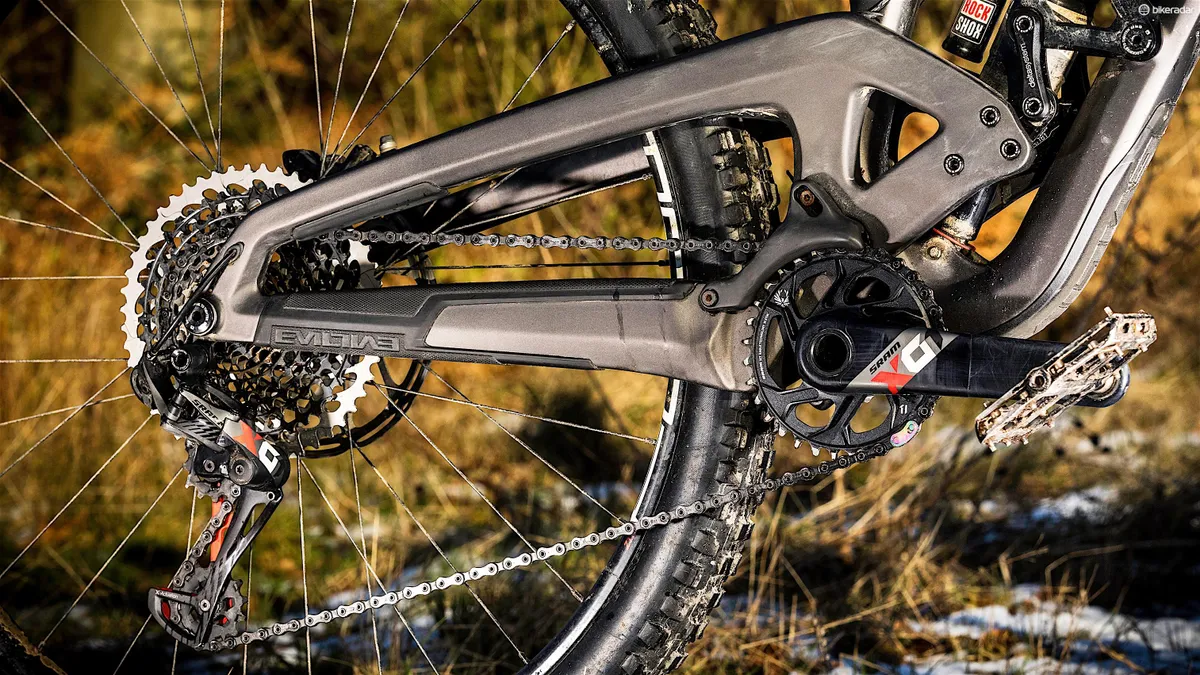We’ve been riding several sets of SRAM’s radical 12-speed XO1 Eagle trail transmission for months now, so what are our fully formed, all-weather, mileage certified opinions?
- Mountain bike groupsets: everything you need to know
- e*thirteen's TRS Race cassette out-gears everyone
- Year in review: the most important mountain bike tech of 2016
The XX1, priced at £1,145 / $1,381 / €1,487 , is literally the golden boy of SRAM’s two Eagle groupsets. Its titanium nitrided chain and 11-speed sprocket stack (the twelfth, 50 tooth driver sprocket at the back is black) are instantly recognisable — and it has two Olympic MTB gold medals to its name too.
However, the cheaper XO1, priced at £977 / $1,157 / €1,269, is the group most riders will be looking at for several good reasons.
Why choose XO1?
For a start, apart from the longer lasting Ti nitride finish, the 10- to 50-tooth cassette and chain are the same.
The black and silver XG-1295 cassette is also £51 less and the shifter and rear mech are only 16g heavier too. 4g is added from steel rather than titanium bar clamp bolts and there’s an alloy rather than carbon lever in the shifter.
Both have downshift levers with a custom tuneable lever angle and both can hook you five gears up the block (so you can pedal easier) in a full sweep.
12g extra comes from an alloy rather than carbon outer jockey wheel cage, but the ‘bend back into shape’ potential of the all-metal jockey wheel cage is likely a bonus for most trail riders anyway, especially as the extra-long arm means it runs closer to the ground with the possibility of debris damage compared to 11-speed mechs.
The 30g added to the complete group weight by the foam core in the XO1 crank arms also makes them more resistant to accidental damage, compared to XX1 crank arms which are totally hollow in the centre.
That all adds up to a pretty compelling argument in favour of XO1 being the toughest and most cost effective of the Eagle options for all but the most gram obsessed racers.
SRAM Eagle's twelve smooth speeds of trickle down promise
XO1 compared to the rest
XO1 compares well with its SRAM predecessors too.
In terms of the gear package (rear mech, shifter, cassette and chain) it’s 79g heavier than 11-speed SRAM XO1 (and even 15g heavier than SRAM GX) in gear terms, but include the cranks and it’s 48g lighter than its predecessor — and it’s only £35 more for the full package or £30 more for just the gears.
Shimano M9000 XTR is definitely ahead on weight and price, weighing 117g less and priced £122.03 / $77.01 / €81.51 cheaper. The full package, including crank, narrows it noticeably to 47g and £10.05 / €68.51, while US buyers will find the tables turned to make SRAM $62.94 cheaper.
Where XO1 Eagle wins is by adding a whole new level of function over any previous mechanical groupset. Most obviously the 12-speed, 10-50T cassette gives a massive 500 percent gear range without any awkward gaping holes in pedalling rhythm.
The largest 42 and 50T cogs also use a narrow/wide tooth design like the jockey wheels and chainring to synchronise shifting perfectly. While helper ramps remove the lurch and scrabble shifting issues you get with every other cassette I’ve used with a larger than 42-tooth top cog.
The spread gives you the option to run a larger chainring for a higher potential top speed but the same easiest ratio, or as we’ve seen on most Eagle bikes, lets you keep top speed the same but give a comically easy end of day/exhausted legs bail out gear.

XO1 wear and tear
Whatever chainring size you choose from the new X-Sync two-tooth profile, the chainring also creates a genuinely tangible improvement in drive efficiency.
By using a stepped and hooked tooth shape form that’s derived from studying worn examples it spreads drive load across three teeth and three chain rollers simultaneously, rather than hanging all your torque off one tooth.
The teeth are also re-profiled around the base for better evacuation of mud/grit etc. that would otherwise form a lingering grinding paste. This improves wear significantly and means all our sample rings are still running fine, with no noticeable structural wear or performance degradation after several months of winter work in the worst UK conditions.
The Eagle Direct Mount chainrings can be fitted to any other SRAM carbon or alloy crank arms that use the three bolt, rounded spline attachment
The chain plates are also smoothly radiused rather than crudely angled like most chains. That means they take far longer to make due to all the extra stamping and shaping processes, but smoother link shoulders mean smoother out shifting, better meshing with the chainring at extreme chain angles and further increases in lifespan of the whole gear set.
The deep, curved, oily finish ‘Powerlock’ joining link is now the strongest rather than the weakest point in the chain, and an upsized 14-tooth lower jockey wheel also reduces chain drag. The result is a transmission that genuinely feels a gear faster for the same power input.
The new mech gets a more consistently tensioned Type 3 clutch, a titanium spring, stiffer mount, stainless bearings and a plastic fitting template for accurate positioning. SRAM’s proven X-Actuation Zero Loss shifter design gives very quick, high definition engagement of the triggers.
SRAM’s cable pull leverage ratio is also much more tolerant of dirty cables or convoluted internal cable routing than Shimano set ups. The result is that Eagle delivers significantly cleaner and quieter, yet more accurate, precise and positive shifting than any other analogue system we’ve used even in the thickest filth or the final laps of a Scottish winter 24hr race.
It’s proving plenty tough in Enduro or epic trail use too with all our samples feeling at least as tight and fresh as Shimano after similar mileages and much tauter than Box’s new challenger.
The overall result is a genuine — cliche alert — game changer and I wouldn’t hesitate to give the gearing performance of XO1 a perfect 5 out of 5.
While there’s a decent balance of weight, stiffness and durability, the XO1 cranks aren’t best in class though, with lighter options from Race Face also feeling significantly stiffer underfoot at peak power.
The Eagle Direct Mount chainrings can be fitted to any other SRAM carbon or alloy crank arms (or Praxis/DMR cranks) that use the three bolt, rounded spline attachment though. The Eagle chain will also work on 11-speed rings from other brands, but not as smoothly and without the wear advantages of the Eagle tooth profiling.
That said if I were buying a full transmission from new I’d still probably opt for a full SRAM set up and offset the slight loss in crank stiffness for the gains in mechanical efficiency through the chain — that choice seems to have worked pretty well for Nino Schurter, Jenny Rissveds and others since Eagle was introduced.

